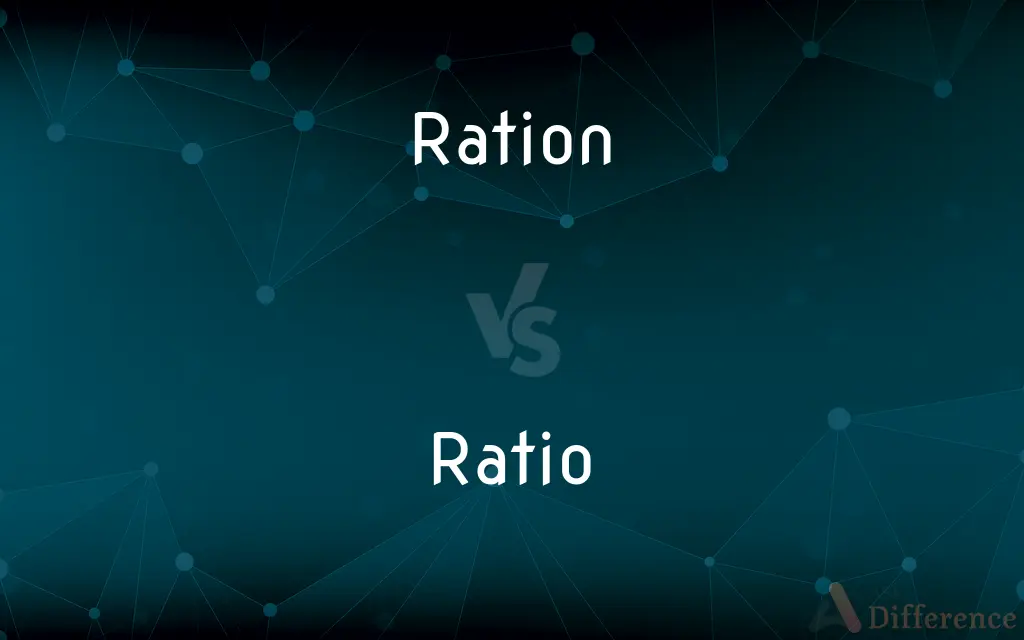Ration vs. Ratio — What's the Difference?
By Urooj Arif & Maham Liaqat — Updated on April 9, 2024
Ration refers to a fixed allowance of provisions or food, while ratio denotes a quantitative relationship between two numbers showing how many times one value contains or is contained within the other.

Difference Between Ration and Ratio
Table of Contents
ADVERTISEMENT
Key Differences
Ration is primarily associated with the controlled distribution of scarce resources, especially food and supplies, during shortages, emergencies, or in military contexts. It implies a limitation or fixed allowance designed to ensure equitable distribution or to preserve scarce resources over time. In contrast, a ratio expresses a mathematical relationship or comparison between two numbers or quantities, illustrating how much of one entity exists in relation to another. This concept is fundamental in mathematics, science, and various forms of data analysis to convey proportions and relative sizes.
In historical contexts, rations have played a critical role in sustaining populations and armies in times of scarcity or conflict, ensuring that individuals receive a minimum necessary quantity of food or supplies. Ratios, on the other hand, have been instrumental in developing and understanding mathematical concepts, scientific phenomena, and financial models. They allow for the expression of relationships in a clear, quantifiable manner, facilitating analysis and decision-making across disciplines.
The concept of a ration is also applied in everyday life, beyond emergency or military use. For instance, individuals might ration their consumption of certain foods or resources to manage health or financial resources. Meanwhile, ratios are used daily in contexts ranging from cooking (mixing ingredients in certain proportions) to business (analyzing financial health through ratios like debt-to-income or profit margins). Both concepts, while distinct, play integral roles in organizational and personal decision-making and resource management.
The administration of rations often involves logistical considerations, including storage, distribution methods, and equitable allocation. It requires an organizational structure to ensure that the distribution is fair and according to the rules set by the managing authority. Ratios, by their nature, require a different kind of administration, one of calculation, analysis, and interpretation. For example, educators might teach students how to calculate ratios in mathematics, or financial analysts might evaluate company performance using various financial ratios.
While rations are a tangible allocation of physical goods, ratios represent abstract relationships between quantities. Rations directly impact the physical well-being and survival of individuals in a practical, immediate sense. Ratios, while they can significantly influence decision-making and theoretical understanding, operate in a more conceptual realm, affecting actions and decisions through the interpretation of relationships and proportions.
ADVERTISEMENT
Comparison Chart
Definition
A fixed allowance of provisions or food
Quantitative relationship between two numbers
Context
Distribution of scarce resources
Mathematical, scientific, and financial analysis
Application
Emergency, military, personal consumption
Data analysis, decision-making, education
Administration
Logistical organization and allocation
Calculation, analysis, interpretation
Nature
Tangible, practical
Abstract, conceptual
Compare with Definitions
Ration
Fixed Allowance.
Soldiers received daily rations to ensure they had enough food in the field.
Ratio
Mathematical Relationship.
The ratio of windows to doors in the building is 2.1.
Ration
Personal Management.
To lose weight, she rations her intake of sugars and fats.
Ratio
Analysis Tool.
Financial analysts use debt-to-income ratios to assess borrowing risk.
Ration
Controlled Distribution.
During the drought, water was rationed to preserve the scarce resource.
Ratio
Educational Concept.
Teaching ratios helps students understand proportional relationships.
Ration
Logistical Considerations.
The logistics team managed the rationing of supplies to the affected area.
Ratio
Versatile Application.
Ratios are used in recipes to maintain flavor and texture.
Ration
Historical Significance.
Rations were crucial for civilian survival during wartime shortages.
Ratio
Abstract Concept.
Ratios express the abstract relationship between quantities or entities.
Ration
A fixed portion, especially an amount of food allotted to persons in military service or to civilians in times of scarcity.
Ratio
In mathematics, a ratio indicates how many times one number contains another. For example, if there are eight oranges and six lemons in a bowl of fruit, then the ratio of oranges to lemons is eight to six (that is, 8∶6, which is equivalent to the ratio 4∶3).
Ration
Rations Food issued or available to members of a group.
Ratio
The quantitative relation between two amounts showing the number of times one value contains or is contained within the other
The ratio of men's jobs to women's is 8 to 1
Ration
To supply with rations.
Ratio
Relation in degree or number between two similar things.
Ration
To distribute as rations
Rationed out flour and sugar.
Ratio
The relative value of silver and gold in a currency system that is bimetallic.
Ration
To restrict to limited allotments, as during wartime
Ration gasoline.
Ratio
(Mathematics) A relationship between two quantities, normally expressed as the quotient of one divided by the other; for example, the ratio of 7 to 4 can be written 7:4 or 7/4. A ratio can often also be expressed as a decimal or percentage.
Ration
A portion of some limited resource allocated to a person or group.
Ratio
A number representing a comparison between two named things.
Ration
(transitive) To supply with a ration; to limit (someone) to a specific allowance of something.
We rationed ourselves to three sips of water a day until we were rescued.
Ratio
(arithmetic) The relative magnitudes of two quantities (usually expressed as a quotient).
Ration
(transitive) To portion out (especially during a shortage of supply); to limit access to.
By the third day on the raft, we had to ration our water.
Ratio
(legal) ratio decidendi
Ration
(transitive) To restrict (an activity etc.)
Our present health care system is rationed only to those who can afford it because of unnecessary high cost, lack of insurance coverage by 47 million people, and exorbitant prescription prices.
Ratio
(Internet) The number of comments to a post or other expression on social media relative to the number of likes; a high ratio suggests disagreement with the contents of the original post.
Ration
A fixed daily allowance of provisions assigned to a soldier in the army, or a sailor in the navy, for his subsistence.
Ratio
To respond to a post or message on social media in a greater number than the number of likes the post receives, especially to condemn or mock the original poster.
The politician's post was quickly ratioed due to its controversial nature.
Ration
Hence, a certain portion or fixed amount dealt out; an allowance; an allotment.
Ratio
Indicates disagreement with a post the user disagrees with or dislikes.
L + ratio
Ration
To supply with rations, as a regiment.
Ratio
The relation which one quantity or magnitude has to another of the same kind. It is expressed by the quotient of the division of the first by the second; thus, the ratio of 3 to 6 is expressed by
Ration
The food allowance for one day (especially for service personnel);
The rations should be nutritionally balanced
Ratio
Hence, fixed relation of number, quantity, or degree; rate; proportion; as, the ratio of representation in Congress.
Ration
A fixed portion that is allotted (especially in times of scarcity)
Ratio
The relative magnitudes of two quantities (usually expressed as a quotient)
Ration
Restrict the consumption of a relatively scarce commodity, as during war;
Bread was rationed during the siege of the city
Ration
Distribute in rations, as in the army;
Cigarettes are rationed
Common Curiosities
How is a ratio different from a fraction?
A ratio compares two quantities, while a fraction represents a part of a whole. Both convey relationships but are used in different contexts.
What is a ration?
A ration is a controlled quantity of resources, especially food, distributed to individuals.
What are some common financial ratios?
Common financial ratios include the debt-to-income ratio, price-to-earnings ratio, and liquidity ratios.
What is the significance of the golden ratio?
The golden ratio is a mathematical ratio often found in nature and art, esteemed for its aesthetically pleasing properties.
Why are ratios important in finance?
Ratios help analyze financial health, operational efficiency, and investment potential by comparing various financial metrics.
How were rations used historically?
Historically, rations were crucial during wars and emergencies to ensure the equitable distribution of scarce resources.
What role do ratios play in education?
Ratios are fundamental in teaching mathematical concepts, fostering analytical thinking.
How does rationing impact society?
Rationing can help manage scarce resources during crises, but may also lead to changes in social behaviors and economic conditions.
Can rations include non-food items?
Yes, rations can include any scarce resource, such as fuel or medical supplies, not just food.
Is rationing still used today?
Rationing is used in emergencies, resource management, and even personal dieting to control consumption.
What's an example of a practical use for ratios?
Ratios are used in cooking to mix ingredients in the correct proportions for recipes.
Can digital resources be rationed?
Digital resources, like bandwidth or access to online services, can be rationed to manage demand and ensure fair distribution.
How do you calculate a ratio?
A ratio is calculated by dividing one quantity by another to find how many times the first quantity contains or is contained within the second.
How do ratios help in decision making?
Ratios provide a quantitative basis for comparisons and assessments, aiding in informed decision making in various fields.
Can rations be adjusted?
Rations can be adjusted based on availability, need, and changes in the situation requiring their use.
Share Your Discovery

Previous Comparison
Higher vs. Upper
Next Comparison
Operation vs. MaintenanceAuthor Spotlight
Written by
Urooj ArifUrooj is a skilled content writer at Ask Difference, known for her exceptional ability to simplify complex topics into engaging and informative content. With a passion for research and a flair for clear, concise writing, she consistently delivers articles that resonate with our diverse audience.
Co-written by
Maham Liaqat















































